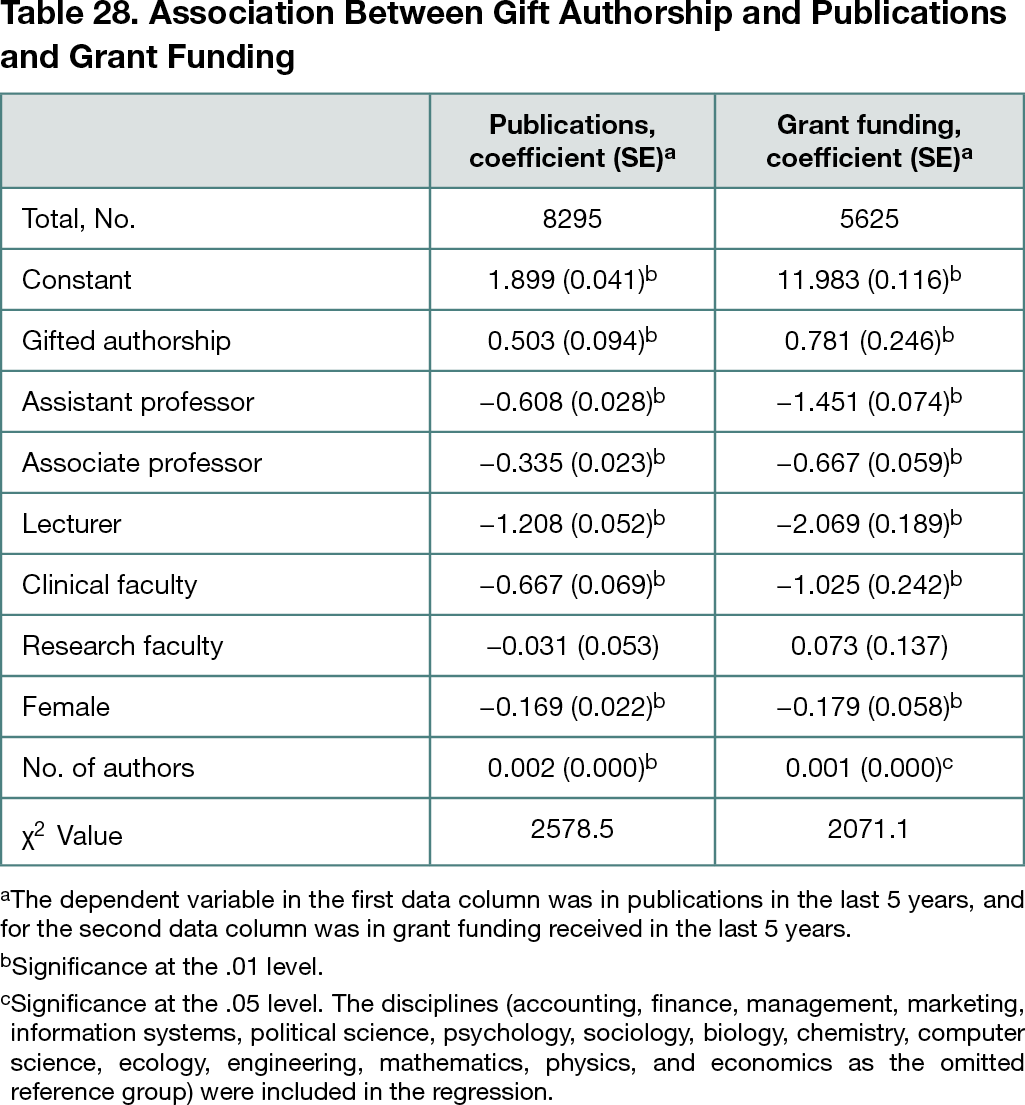Abstract
Association Between Gift Authorship and Peer-Reviewed Publications and Research Funding Awarded Through Competitive Grants in Different Disciplines
Eric A. Fong,1 Yeolan Lee,1 Allen W. Wilhite2
Objective
Recent studies have found gift authorship to be one of the most prevalent types of research misbehavior,1,2 and prior research reported gifting rates between 20% and 50%.3 This study suggests one reason for its popularity may be due to its association with publications and grant funding, 2 commonly used measures of academic success.
Design
Using a convenience sample, surveys were sent to approximately 118,400 faculty from the top 200 universities listed in US News & World Report. Respondents self-reported their academic rank and discipline as well as their publications, grant funding, and experience with gift authorship, in the preceding 5 years. They were also asked the main reason why their most recent gift authorship was given to a particular individual (ie, the gift recipient). Surveys were distributed in 2012 to 2014; this study used responses to 11 of the 28 questions, excluding questions that addressed other forms of misconduct. Data were analyzed using 2-stage least squares regression: the first stage explored who was more likely to add a gift author and the second stage measured the associations between gift authors, publications, and grant funding. Responses were then separated into 2 gift recipient types: administrative roles or nonadministrative colleagues. The associations of gifting with publications and with grant funding were then recalculated and compared.
Results
The response rate to the survey was 10.4% (12,317/118,400); this was about what was expected given the length of the cover email, the length of the survey, and the potential the emails were directed to junk mail, filtered as spam, etc. Of the 12,317 responses, incomplete surveys and responses from unrelated disciplines reduced the usable sample to 10,689 responses. Of the respondents who responded to rank and sex questions, 33.2% (3956/11,919) were female, 21.2% (1878/8838) were assistant professors, 27.4% (2418/8838) were associate professors, 46.2% (4080/8838) were professors, and the balance consisted of other ranks. Thirty-five percent (3749/10,698) of respondents admitted to participating in gift authorship. The results showed a positive association between the practice of gift authorship and a scholar’s number of publications and their research funding (Table 28). Furthermore, adding an administrator as a gift author was correlated with larger increases in publications and more grant funding than gifting nonadministrator colleagues.
Conclusions
The association between participating in gift authorship and academic success in the US, documented in this study, suggested that it could be difficult for the academy to reduce the use of gift authorship unless tangible costs and enforcement of those costs are in place.
References
1. Reisig MD, Holtfreter K, Berzofsky ME. Assessing the perceived prevalence of research fraud among faculty at research-intensive universities in the USA. Account Res. 2020;27(7):457-475. doi:10.1080/08989621.2020.1772060
2. Bouter LM, Tijdink J, Axelsen N, Matinson BC, Ter Riet G. Ranking major and minor research misbehaviors: results from a survey among participants of four World Conference on Research Integrity. Res Integ Peer Rev. 2016;1:17. doi:10.1186/s41073-016-0024-5
3. Elliott KC, Settles IH, Montgomery GM, Brassel ST, Cheruvelil KS, Soranno PA. Honorary authorship practices in environmental science teams: structural and cultural factors and solutions. Account Res. 2017; 24(2):80-98. doi:10.1080/08989621.2016.1251320
1Department of Management, Marketing, and Information Systems, University of Alabama in Huntsville, AL, USA, eric.fong@uah.edu; 2Department of Accounting, Economics, and Finance, University of Alabama in Huntsville, AL, USA
Conflict of Interest Disclosures
None reported.
Funding/Support
This study was supported by the Office of Research Integrity through the Department of Health and Human Services (grant ORIIR130003).
Additional Information
The content is that of the authors and does not necessarily represent the official views of, nor an endorsement by, the Health Resources and Services Administration, Department of Health and Human Services, or the US government.

